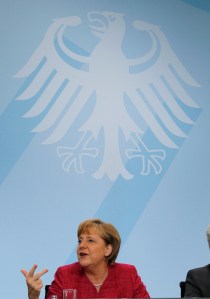
German Chancellor Angela Merkel
As I’ve traveled around Europe, I’ve learned that nuclear energy is seen very much through cultural lenses. The French jealously guard their force de frappe nuclear weapons and slurp up nuclear power with no heartburn or concern. Next door in Germany, where fear of the atomkraft helped form the country’s powerful Green party in the wake of Chernobyl, politicians are scrambling to get NATO’s nuclear weapons out of Europe and a full 70 percent of the population oppose nuclear power.
So it should come as no surprise that, in the wake of Fukushima, even Chancellor Angela Merkel—a physicist by training and qualified nuclear power supporter—should turn her back on nuclear. On Monday, she announced a policy reversal that will see Germany close all of its 17 nuclear reactors by 2022.
But don’t take this to be a sign that the nuclear renaissance is kaputt.
“After what was, for me anyway, an unimaginable disaster in Fukushima, we have had to reconsider the role of nuclear energy,” Merkel said at a news conference, announcing a u-turn on a plan passed by Merkel’s government last fall that would have extended the lifetime of some of Germany’s reactors into the 2030s as a “bridge technology” until renewables could take over. The new plan is essentially a return to the policy of the preceding Social Democrat-Green coalition, which approved a nuclear phase out in 2002.
“Unimaginable” is a telling word choice: many countries have announced plans in recent years to invest in nuclear energy because, 25 years after Chernobyl, they had come to believe that a nuclear accident was not possible. Now many countries are re-evaluating that confidence. Switzerland has approved a plan to decommission its nuclear plants, Italy recently extended a moratorium on nuclear power and several other countries including China are holding reviews before moving forward with new reactors.
But other countries—the U.S., U.K., and Poland to name but a few—will proceed with nuclear power despite Fukushima, as will many developing countries. And it’s even questionable whether Germany—with it’s booming, heavy industries—will manage to meet its energy demands without nuclear power. Areva’s CEO Anne Lauvergeon told the Wall Street Journal that Germany would likely have to go the route of Austria, which has opposed nuclear power plants inside its own borders even as it imports nuclear energy from neighboring countries. Of course, Lauvergeon would say this, as it’s French nuclear energy that Germany would likely turn to in the future.
But there’s no doubt that, in Germany and elsewhere, meeting increasing energy demands while also tackling climate change will make it difficult to shun any low-carbon energy sources, no matter how troubling. Remember Pacala and Socolow‘s seven “stabilizing wedges,” each of which represents a technology that grows enough to avoid the emission of one billion tons a year of carbon by 2050? To make nuclear power one of these wedges would require tripling the world’s current nuclear power generating capacity by replacing all the world’s reactors and building some 25 reactors (of current average size) every year around the world until 2050.¹ That’s how big these “wedges” need to be: and some even estimate they need to be larger than Pacala and Socolow envisaged. It’s no wonder that some countries feel that nuclear—as a proven, low-carbon source—is worth the risk.
Some anti-nuclear campaigners say that the growth required in nuclear generating capacity to even make a dent in the fight against climate change is unattainable—no new reactors were connected to the grid anywhere in the world in 2008 and only two were in connected in 2009. Regulatory hurdles and complicated construction means it takes at least a decade to bring new plants on-line–and possibly more if regulations tighten following Fukushima. But saying the the threat of climate change is too large or too urgent for nuclear power seems illogical—we’re going to need as much help as we can get.
If I were Angela Merkel’s energy adviser, I’d tell her to stay the course on nuclear, but also work to promote global action that would make nuclear power safe and secure so that another Fukushima becomes entirely imaginable, because we’ve done everything we can do to anticipate it and prevent it from happening again.
¹ Source: Promoting Safe, Secure, and Peaceful Growth of Nuclear Energy: Next Steps for Russia and the United States; pg 3, 5 and 6, published by Harvard’s Project on Managing the Atom & the Kurchatov Institute, available by clicking here.


